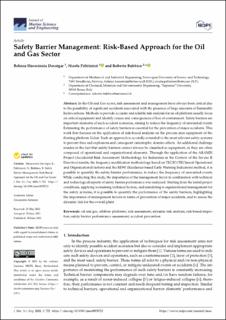| dc.contributor.author | Hosseinnia Davatgar, Behnaz | |
| dc.contributor.author | Paltrinieri, Nicola | |
| dc.contributor.author | Bubbico, Roberto | |
| dc.date.accessioned | 2023-02-22T10:50:24Z | |
| dc.date.available | 2023-02-22T10:50:24Z | |
| dc.date.created | 2021-12-14T10:50:31Z | |
| dc.date.issued | 2021 | |
| dc.identifier.citation | Journal of Marine Science and Engineering. 2021, 9 (7), . | en_US |
| dc.identifier.issn | 2077-1312 | |
| dc.identifier.uri | https://hdl.handle.net/11250/3053169 | |
| dc.description.abstract | In the Oil and Gas sector, risk assessment and management have always been critical due to the possibility of significant accidents associated with the presence of large amounts of flammable hydrocarbons. Methods to provide accurate and reliable risk analysis for an oil platform usually focus on critical equipment and identify causes and consequences of loss of containment. Safety barriers are important elements of such accident scenarios, aiming to reduce the frequency of unwanted events. Estimating the performance of safety barriers is essential for the prevention of major accidents. This work first focuses on the application of risk-based analysis on the process area equipment of the floating platform Goliat. Such an approach is secondly extended to the most relevant safety systems to prevent fires and explosions and consequent catastrophic domino effects. An additional challenge resides in the fact that safety barriers cannot always be classified as equipment, as they are often composed of operational and organizational elements. Through the application of the ARAMIS Project (Accidental Risk Assessment Methodology for Industries in the Context of the Seveso II Directive) results, the frequency modification methodology based on TEC2O (TEChnical Operational and Organizational factors) and the REWI (Resilience-based Early Warning Indicators) method, it is possible to quantify the safety barrier performance, to reduce the frequency of unwanted events. While conducting this study, the importance of the management factor in combination with technical and technological aspects of safety barrier performance was analyzed. Starting from the initial project conditions, applying worsening technical factors, and simulating n organizational management for the safety systems, it is possible to quantify the performance of the safety barriers, highlighting the importance of management factors in terms of prevention of major accidents, and to assess the dynamic risk for the overall plant. | en_US |
| dc.language.iso | eng | en_US |
| dc.publisher | MDPI | en_US |
| dc.rights | Navngivelse 4.0 Internasjonal | * |
| dc.rights.uri | http://creativecommons.org/licenses/by/4.0/deed.no | * |
| dc.title | Safety barrier management: Risk‐based approach for the oil and gas sector | en_US |
| dc.title.alternative | Safety barrier management: Risk‐based approach for the oil and gas sector | en_US |
| dc.type | Peer reviewed | en_US |
| dc.type | Journal article | en_US |
| dc.description.version | publishedVersion | en_US |
| dc.source.pagenumber | 21 | en_US |
| dc.source.volume | 9 | en_US |
| dc.source.journal | Journal of Marine Science and Engineering | en_US |
| dc.source.issue | 7 | en_US |
| dc.identifier.doi | 10.3390/jmse9070722 | |
| dc.identifier.cristin | 1968143 | |
| cristin.ispublished | true | |
| cristin.fulltext | original | |
| cristin.qualitycode | 1 | |

